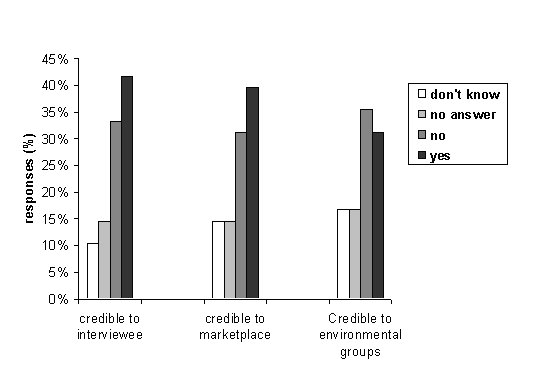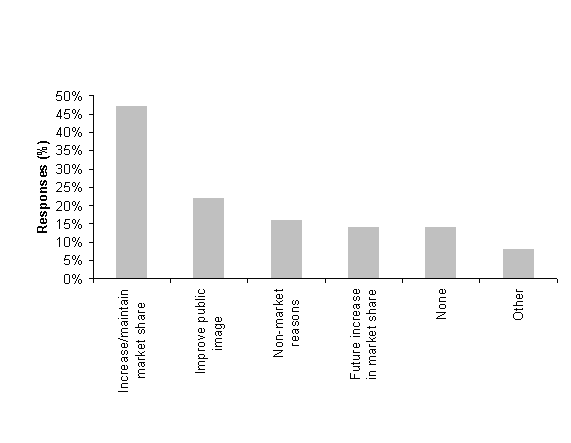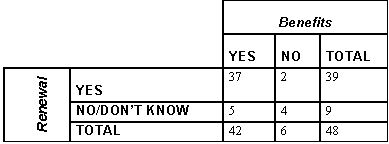
Research Question 1: How do the various certification systems differ in
their approach to “supply chain verification”? The different supply chain verification systems suit the needs of the organizations
involved. They are viewed as equally credible to the market place by FSC processors,
distributers and retailers in North America. The FSC is perceived as more credible
to environmental groups than the CSA or SFI by these respondents. Our survey
inquired about the reasons for certification with the FSC instead of a competing
system. We recieved the following responses: FSC is most stringent (40%), it
is the most established (31%), customers demand it (23%), and it is internationally
recognized (21%). Only 13 percent of respondents selected the FSC because they
were unaware of comparable certification systems. Respondents seemed to be well
aware of the comparable certification systems which are active in North America.
81 percent of respondents were aware of the parallel certification systems run
by the CSA and SFI. The FSC is, structurally, the most developed COC certification
system. (Figure 1)
The Role of Chain of Custody Systems
Data Analysis
i) Supply chain verification systems differ primarily to the extent to which their
methods of verification are credible.
ii) The FSC has the most developed, stringent, and well recognized supply chain
verification system.

Figure 1= Figure 5.1.1. Interviewee Perceived Credibility of SFI and CSA systems as compared to FSC
Research Question 2: What are the motivations for becoming COC certified?
Hypothesis:Our data demonstrates that the main motivation to become certified is market access. 75 percent of respondents were motivated by market access, compared to 33 percent by environmental concern, and 15 percent by public pressure (ie. pressure from environmental NGOs or the general public). Another interesting result seen is that none of our respondents mentioned premiums as a motivating factor for becoming certified.
In order to gain a greater understanding of the importance of market access within the FSC COC certification system, we cross-referenced the 36 companies that responded market access as their motivation for certification with their benefits from certification. Our goal was to reveal the extent to which the motivations for certification are realized as benefits. Of the 36 organizations that became certified for market access, 47 percent received the benefit of increased/maintained market access. (Figure 2) This value makes it clear that the main benefit received by companies does in fact correspond to their primary motivating factor. Another interesting finding from this exercise was that 14 percent of those organizations that were motivated by market access do not claim to receive any benefits from certification.

Research Question 3: How are North American COC certified companies affected by their certification?
Hypotheses:Our data reveals that most companies interviewed have invested between 1001 and 100,000 US dollars. These costs, can largely be attributed to the price of certification itself, the yearly auditing required and to various company specific internal adjustments. The two most common internal adjustments reported were record keeping and product handling. Such adjustments reflect the FSC’s requirements to keep certified products separate from non-certified products and to maintain detailed accounts of such products. Surprisingly, 11 percent of interviewed companies responded that they had made no significant internal adjustments for certification. For some of companies the product handling and record keeping systems in place before certification were so adequate that no changes were needed. Similarly, companies already certified under ISO or SFI, for example, already had the necessary procedures in place, and were thus not required to undergo any significant changes. Our analysis found that 76 percent of companies had not yet recuperated the costs of their certification. Our first hypothesis is thus supported by our data, as the majority of companies holding FSC COC certificates appear to have not yet recuperated the costs of their certification.
Such findings were expected, given the relative youth of certification and the corresponding fact that most companies had only just recently become certified. Among the companies interviewed, the longest FSC membership was 8 years old. Such was an exception however, as 75 percent of our companies had acquired their certification during or prior to the year 2000. Given the recent nature of certification, our data was unable to test for an association between the number of years a company has been certified, and whether or not they have recuperated their costs. Such information might be available in a few more years when more companies may have recuperated their costs. Other reasons explaining why companies had not yet recuperated their costs might include the fact that in general, companies are only selling a very small proportion of certified wood products. Our data illustrates that 77 percent of companies that plan to renew their certification have less than 20 percent in certified sales. Furthermore, 27 percent of all companies (n=30) are currently selling no certified wood products. A third explanation as to why companies are not recuperating their costs of certification lies perhaps in the fact that most companies are not receiving premiums from the sales of their certified wood products. Our results reflects that 80 percent of companies have not received a premium on their certified FSC COC products.
Given that most companies are incurring significant costs through their certification, and that most have yet to recuperate these costs, the question arises as to why these companies are renewing their certification. Looking into the reported benefits of certification helps to answer this question. The types of benefits most commonly reported were: retaining market access (42%), improving public image (31%), non-market benefits (17%), and future market access (13%). The presence of market access (retained or future) as a reported benefit was a particularly significant finding, as it was also the most important motivation behind attaining certification. None of our respondents mentioned premiums as a motivation for becoming certified. Another interesting finding was the prevalence of non-market benefits that were received (17%). These include aesthetic benefits or benefits arising from supporting the local community. This is noteworthy given that forest certification was established as a market mechanism to promote sustainable forestry. However, as our data suggests, benefits unrelated to the market appear to play a key role in determining whether certain organizations renew their FSC COC certification.
Benefits in fact appear to be intricately tied to whether or not companies will renew their certification. Our survey revealed that 82 percent of companies plan to renew their certificate when it expires. Also, 88 percent of companies report receiving benefits from certification. Figure 3 examines the results of cross referencing data on received benefits with data pertaining to renewal. It was found that 88 percent of those organizations that receive benefits from certification also plan to renew their certification when it expires. Our data suggests that the benefits derived from certification are extremely important to the future of certification even though many of the potential market based benefits have yet to be realized.

Figure
3 = Figure 5.3.8 Renewal of Certification versus benefits derived from certification
(n=48).
Research Question 4: What are the dynamics within the FSC supply chain and how do they affect the different players in the chain of custody?
Hypotheses:Organization size is not a limiting factor in acquiring FSC COC certification. We assessed the geographic location of the different companies, the type of products they sell, and finally the size of their organization. In terms of location, it should be noted that of the responding companies, 83 percent of them were chosen from the United States, with the remaining in Canada. The portion of respondents located in the west was found to be the same as the portion located in the northeast. Similarly, the portion of respondents located in the south was equal to that of those located in the north central.
Information concerning product profile was obtained from the FSC database. In terms of wood products, lumber and architectural products were found to occupy the largest share, with respective values of 28 and 26 percent (n=47). Architectural products included doors, moldings and siding. All other categories of wood products accounted for a surprisingly similar proportion, ranging from 9 to 13 percent. The latter includes furniture, plywood, veneer, specialty products, logs, brokerage, flooring and other products. While lumber was also the most commonly found product in the studies conducted by Humphries et al (2001) and Carter and Merry (1998), flooring was a significant second (with 41% and 27% respectively), whereas in our study it is placed last at 9 percent.
Overall, most of the firms that we contacted were not able to obtain an addequate supply of certified products. Exceptions occured where a company's original supply had become certified.
We were also able to verify our third hypothesis. 23% of our respondants claimed that they were motivated to become certified by one of their customers.
© 2002 McGill School of Environment
McGill University
3534 University, Montreal, Quebec, Canada H3A 2A7